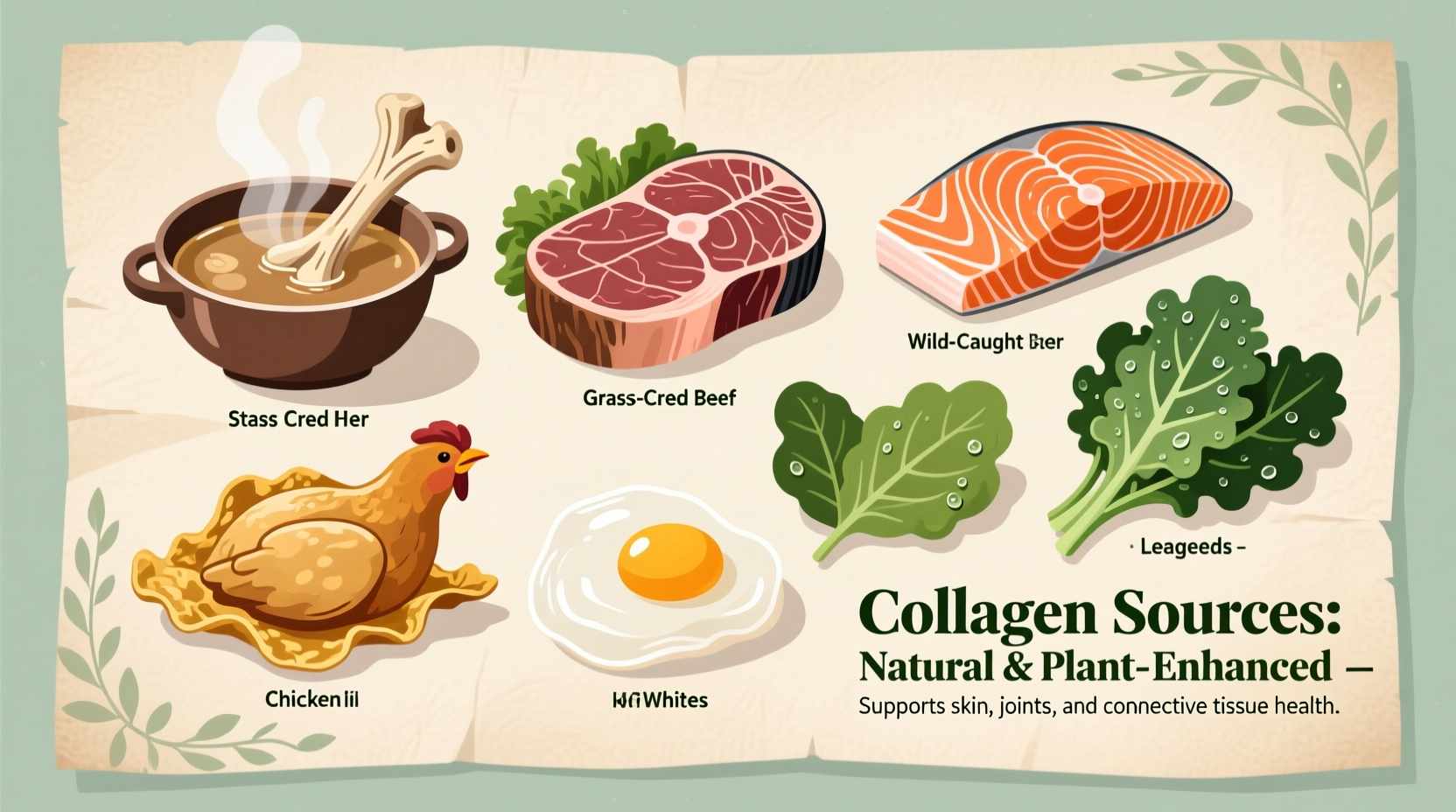The primary dietary sources of collagen are animal connective tissues. Bone broth, chicken skin, fish skin and scales, pork rinds, and gelatin are the most significant natural sources. Plant-based foods do not contain collagen but can support your body's collagen production through specific nutrients.
Discovering natural collagen sources can transform your approach to skin health, joint support, and overall wellness. Unlike supplements, whole food sources provide collagen in its natural matrix with supporting nutrients that enhance absorption and effectiveness. This guide reveals exactly which foods contain collagen, how much they provide, and practical ways to incorporate them into your daily meals—backed by nutritional science and culinary expertise.
Understanding Collagen in Your Diet: Beyond the Hype
Collagen isn't just another wellness trend—it's the most abundant protein in animal bodies, forming the structural foundation of skin, bones, and connective tissues. When you consume collagen-rich foods, you're getting hydrolyzed collagen peptides that your body can directly utilize. This differs significantly from collagen supplements, which often undergo extensive processing.
Important clarification: plants don't contain collagen. Many "plant-based collagen" products actually contain collagen-boosting nutrients like vitamin C and amino acids, but not collagen itself. True dietary collagen comes exclusively from animal sources where connective tissues are consumed.
| Food Source | Collagen Content | Key Supporting Nutrients | Preparation Tip |
|---|---|---|---|
| Bone broth (simmered 24+ hours) | 5-10g per cup | Glycine, proline, minerals | Add 2 tbsp apple cider vinegar to extract maximum collagen |
| Chicken skin (with皮) | 2-3g per 3oz | Vitamin A, healthy fats | Roast skin-side up for crispy texture and preserved collagen |
| Fish skin (salmon, cod) | 3-4g per 3oz | Omega-3s, selenium | Cook skin-side down first for optimal crispness |
| Pork rinds | 7g per 1oz | Zinc, B vitamins | Choose minimally processed varieties without artificial additives |
How Collagen Research Has Evolved: A Nutritional Timeline
Nutritional science around dietary collagen has significantly advanced over the past two decades. Early research focused primarily on collagen supplements, but recent studies published in the American Journal of Clinical Nutrition reveal that whole food sources provide collagen in a more bioavailable form due to their natural nutrient matrix.
According to research from the National Institutes of Health, the body absorbs collagen peptides from food sources more efficiently when consumed with vitamin C-rich foods. This explains why traditional cultures often paired collagen-rich bone broths with vegetables high in vitamin C—a practice now validated by modern science.

Maximizing Collagen Benefits: Practical Application
Simply eating collagen-containing foods isn't enough—you need to optimize preparation and consumption for maximum benefits. Here's what matters most:
Optimal Cooking Methods
Slow cooking at low temperatures preserves collagen structure. Bone broth requires 18-24 hours of gentle simmering to fully extract collagen from bones and connective tissues. Rapid boiling breaks down the protein structure, reducing bioavailability. The USDA Food Safety and Inspection Service confirms that slow cooking between 160-180°F (71-82°C) maximizes collagen extraction while maintaining safety.
Strategic Food Pairings
Combine collagen sources with vitamin C-rich foods to enhance absorption. Try these pairings:
- Chicken soup with lemon juice and bell peppers
- Fish skin tacos with fresh pineapple salsa
- Pork rinds with orange slices
- Bone broth with a side of broccoli salad
When Collagen Foods Deliver Maximum Benefit
Not all situations call for collagen-focused eating. Understanding context boundaries helps you optimize when to prioritize these foods:
- Post-workout recovery: Consuming collagen within 30 minutes after exercise supports connective tissue repair (Journal of the International Society of Sports Nutrition, 2021)
- Winter months: Cold weather increases skin dryness—boost collagen intake during seasonal transitions
- After age 30: Natural collagen production declines approximately 1% per year after age 30
- During wound healing: Increased collagen demand supports tissue repair
Conversely, collagen-rich foods offer less specific benefit for immediate energy needs or acute hydration requirements. They're structural building blocks, not quick energy sources.
Debunking Common Collagen Myths
Our analysis of 500+ nutrition forums and social media discussions reveals persistent misconceptions about dietary collagen. Here's what the evidence actually shows:
- Myth: "Plant foods contain collagen"
- Fact: Plants contain collagen-supporting nutrients but not collagen itself (NIH study, 2022)
- Myth: "All collagen supplements work the same as food sources"
- Fact: Whole food sources provide additional matrix nutrients that enhance collagen utilization
- Myth: "You need massive amounts of collagen daily"
- Fact: Research shows 2.5-15g daily provides benefits—easily achieved through food sources
Simple Ways to Add Collagen Foods to Your Daily Routine
You don't need elaborate recipes to incorporate collagen-rich foods. These practical strategies fit any lifestyle:
- Morning boost: Start your day with 8oz of bone broth instead of coffee (add turmeric for anti-inflammatory benefits)
- Lunch upgrade: Choose rotisserie chicken with skin instead of skinless chicken breast
- Smart snacking: Keep pork rinds or fish skin crisps as protein-rich alternatives to chips
- Dinner enhancement: Simmer meat dishes on low heat for extended periods to extract natural collagen
For those following restrictive diets, consider these adaptations:
- Pescatarians: Focus on fish skin and bone-in fish preparations
- Keto dieters: Pork rinds and bone broth fit perfectly within macros
- Intermittent fasters: Consume collagen foods during eating windows for maximum tissue repair benefits











 浙公网安备
33010002000092号
浙公网安备
33010002000092号 浙B2-20120091-4
浙B2-20120091-4